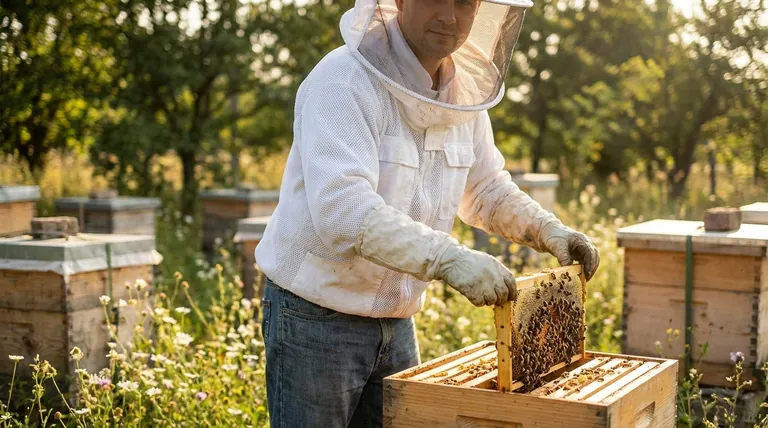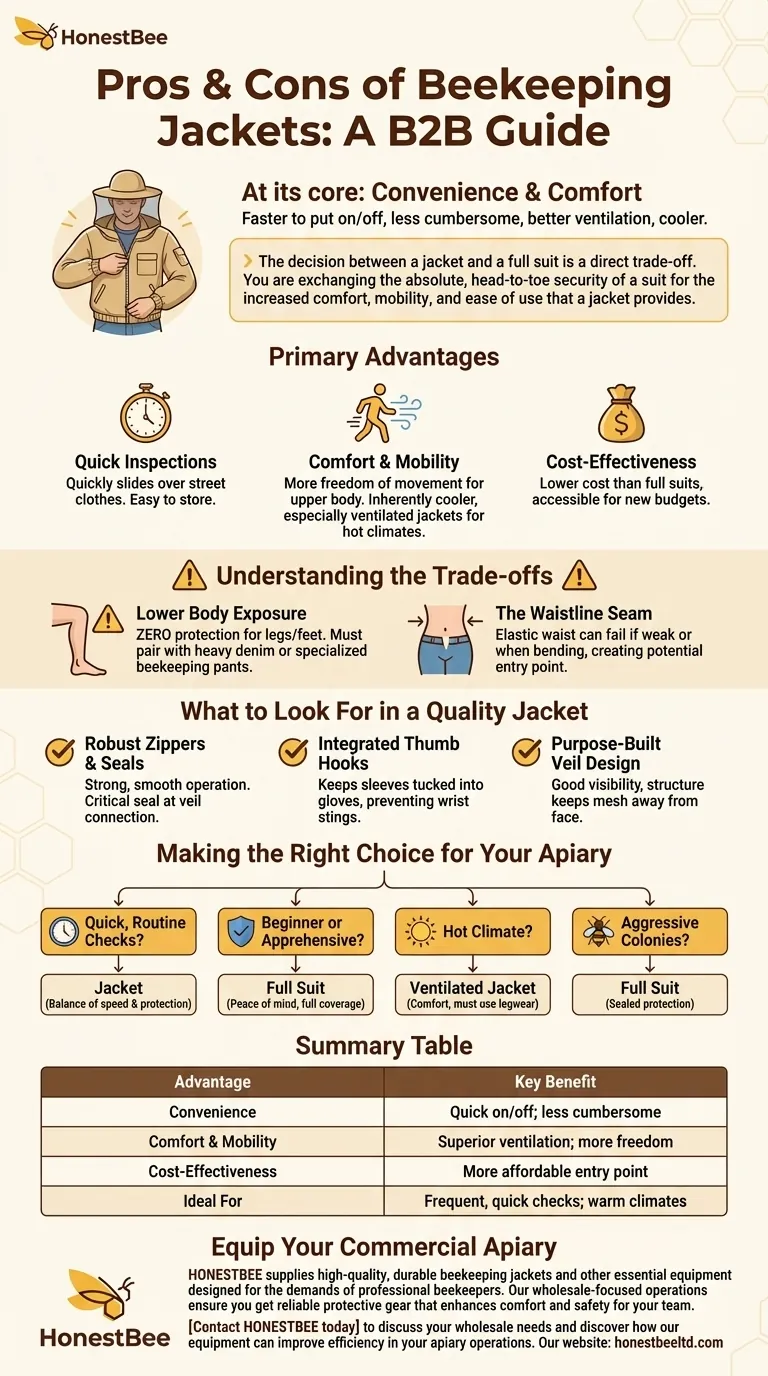At its core, a beekeeping jacket offers a significant advantage in convenience and comfort. Compared to a full bee suit, a jacket is faster to put on and take off, less cumbersome to work in, and provides better ventilation, making it a cooler option for warm days. This combination of ease and comfort makes it a highly popular choice for many beekeepers.
The decision between a jacket and a full suit is a direct trade-off. You are exchanging the absolute, head-to-toe security of a suit for the increased comfort, mobility, and ease of use that a jacket provides.

The Primary Advantages of a Beekeeping Jacket
A beekeeping jacket is purpose-built for efficiency and comfort during hive interactions. Its design prioritizes the most common needs of a beekeeper performing routine tasks.
Unmatched Convenience for Quick Inspections
For beekeepers who need to perform frequent but brief hive checks, a jacket is exceptionally practical. It slides on and off quickly over your street clothes.
This "grab-and-go" nature means it is also less cumbersome to store, taking up less space in a vehicle or shed than a full, one-piece suit.
Superior Comfort and Mobility
Without the attached pants, a jacket provides more freedom of movement for your upper body. This can make tasks like lifting heavy supers or manipulating frames feel less restrictive.
The primary comfort advantage is temperature regulation. Jackets are inherently cooler than suits, and modern ventilated jackets use layered mesh to maximize airflow, a critical feature for beekeeping in hot climates.
A More Accessible Entry Point
From a financial perspective, a high-quality beekeeping jacket almost always costs less than its full-suit equivalent. This makes it an attractive and more accessible starting point for new beekeepers managing their initial budget.
Understanding the Trade-offs: Protection vs. Comfort
While a jacket excels in convenience, this comes with a critical compromise in protection that you must actively manage.
The Critical Weak Point: Lower Body Exposure
A jacket offers zero protection for your legs and feet. This is its single most significant drawback. Bees that are knocked off the hive or become agitated can easily target your lower body.
To mitigate this, you must pair your jacket with appropriate legwear. Heavy, light-colored denim jeans or specialized beekeeping pants are mandatory. Never wear shorts, thin leggings, or dark-colored pants.
The Waistline Seam
Beekeeping jackets feature a built-in elastic waistline designed to create a seal against your body. This is a crucial feature for preventing bees from crawling up inside your jacket.
However, this seam is a potential point of failure. If the elastic is weak or if you bend over extensively, a gap can form, creating an entry point for a determined bee. This is a risk that a zippered, one-piece suit eliminates entirely.
What to Look For in a Quality Jacket
Not all jackets are created equal. Certain features distinguish a reliable piece of equipment from a potential liability.
Robust Zippers and Secure Seals
Pay close attention to the zippers. They should be strong and operate smoothly. The zipper connecting the veil to the jacket collar is particularly important, as a faulty seal here is a direct path to facial stings.
Integrated Thumb Hooks
Quality jackets include thumb hooks or elastic loops at the end of the sleeves. This simple feature is vital for keeping the sleeves securely tucked inside your gloves, preventing any exposed skin at the wrist.
Purpose-Built Veil Design
The jacket's veil should offer good visibility and structure, keeping the mesh away from your face even when you turn your head.
Making the Right Choice for Your Apiary
Your choice of protective gear should be a deliberate decision based on your temperament, your bees, and your climate.
- If your primary focus is quick, routine hive checks: A jacket provides the ideal balance of speed and sufficient protection, especially with calm colonies.
- If you are a beginner or feel apprehensive: A full suit might offer greater peace of mind, removing any worry about lower-body protection as you learn.
- If you work in a hot climate: A ventilated jacket is an excellent choice for comfort, but you must remain disciplined about wearing protective legwear.
- If you anticipate dealing with aggressive colonies: The complete, sealed protection of a full suit is the most prudent choice.
Ultimately, the best protective gear is the one that allows you to work confidently and safely in your specific environment.
Summary Table:
| Advantage | Key Benefit |
|---|---|
| Convenience | Quick to put on/take off; less cumbersome than a full suit |
| Comfort & Mobility | Superior ventilation; more freedom of movement for upper body |
| Cost-Effectiveness | More affordable entry point for new beekeepers |
| Ideal For | Frequent, quick hive checks; beekeeping in warm climates |
Equip your commercial apiary or distribution business with the right gear. HONESTBEE supplies high-quality, durable beekeeping jackets and other essential equipment designed for the demands of professional beekeepers. Our wholesale-focused operations ensure you get reliable protective gear that enhances comfort and safety for your team.
Contact HONESTBEE today to discuss your wholesale needs and discover how our equipment can improve efficiency in your apiary operations.
Visual Guide

Related Products
- Cotton Beekeeping Suit and Round Hat with Veil Bee Keeper Protective Gear
- Beekeeping Jacket with Hood and Veil for Beekeepers
- Economy Polyester Beekeeping Jacket with Veil and Hat
- White Beekeeping Protective Suit and Hat with Fencing Veil for Beekeepers
- Heavy Duty Cowboy Beekeeper Hat with Visibility Veil Outdoor Professional Beekeeping Protective Gear
People Also Ask
- What factors should be considered when choosing a beekeeping suit? Balance Safety, Comfort & Performance
- What should be considered regarding the color of beekeeping clothing? Ensure Your Safety and Keep Bees Calm
- Do beekeeping suits completely prevent stings? Maximize Your Apiary Safety with the Right Gear
- What are the benefits of a fully ventilated beekeeping suit? Stay Cool and Protected in Hot Climates
- Why is a jacket with a hat veil recommended for beekeepers? Essential Protection for Your Face and Neck



















